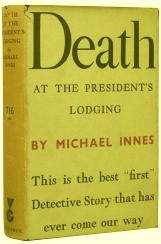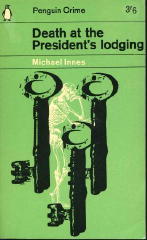Fri 29 Aug 2008
MICHAEL INNES – Seven Suspects. Berkley F1158, paperback reprint, November 1965. US hardcover edition: Dodd Mead, 1937. First published in the UK as Death at the President’s Lodging, Victor Gollancz, hardcover, 1936. [Other US paperback editions include: Dolphin, 1962; Penguin, 1984.]

Without a doubt, in terms of intelligence and general all-around erudition, Michael Innes has to be ranked in the top five mystery writers of all time. (I don’t know how you’d put this to a test, but I can think of only a handful I might start comparing him to, and the funny thing is, they’re all English.)
In the beginning, though, he seems to have been too intellectual for his own good. Seven Suspects was his first mystery novel, and in spite of the great start and the fine setup, to get through the middle portion of the book involves some very tough slogging, to use the vernacular, at least by contemporary standards.
The great start? Well, it’s not quite a locked room mystery, but it’s the next best thing. And speaking of which, what this (Berkley) edition of the novel needs, more than anything else, is a map, a map of St. Anthony’s College, where the President is found shot to death in his Lodging, with gardens and walls and locked doors all around, and only a limited number of keys with which to open them.

There could hardly be a greater contrast between the two officers of the law involved, deliberately so. The local copper is the prosaic Inspector Dodd, far more comfortable with tracking down a gang of burglars than a shrewd and wily killer who leaves a puzzling trail of enigmatic clues behind.
On the other hand, the nimble-witted Inspector John Appleby, sent down quickly by Scotland Yard, is perfect for dealing with the retinue of eccentric academics who never seem to speak before thinking twice (or thrice) about the implications of what they are about to utter.
Being a native Midwesterner by birth, American style, I have to confess that some of the doings in the aforementioned middle portion of the book, carried out by a small company of carefree undergraduates of the college, were intended to be funny, but not to me. To the average Londoner at the time, they probably were — and maybe even hilarious. (It took me a chapter or two of such antics, but I did finally get into the spirit of things.)
What is also true, as I came to realize toward the end of the book, is that not a single female appears who has a speaking part, and only one who’s in the book at all has more than a servant’s role. (In all truthfulness, it took Innes’s own observation of this patricluar fact for me to notice. Sometimes I really am slow.)
And so, this combination of dry academic humor and a decidedly noticeable lack of authorial interest in Appleby the person — that is to say his personal life, his worries and concerns — it all makes this Golden Age gem far out of the mainstream of the mystery world today.
But gem it is. There are some flaws — it’s a wholly artificial staging, of course — but the comings and goings the night of the murder, who did what when, and who saw what and who didn’t, whose voice that was, and whose it wasn’t, it’s a eye-popper and a mind-blower, and my head is still spinning.
A gem that needs some polishing, then, but for an academic exercise in the pure pleasure of plotting, very very few of the thousands of mysteries ever published come even close to topping this one.
August 29th, 2008 at 7:17 pm
I most remember Hamlet’s Revenge and The Long Farewell ( I think that was it). Thanks again.
August 29th, 2008 at 8:03 pm
I’m not positive, but this may be the only book by Innes that I’ve read over the past 30 years. Before that, I read a lot of them, but remember them? No.
Re-reading my own review from 6 years ago, I’ve just convinced myself. I really have to do something about that.
But see some of my recent post. I just thought the same thing about Mickey Spillane’s books. (On the other side of the mystery spectrum, of course.)
Where do I start?
It’s a dilemma, that’s for sure.
— Steve
May 10th, 2009 at 12:38 am
[…] might want to go back and read my review of Innes’s Seven Suspects first, as I’m going to go out on a limb here, and say that that book […]